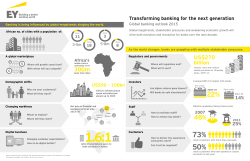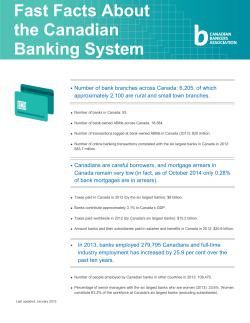
Two banks fail Fed`s stress test while most lenders celebrate
NUS Risk Management Institute rmicri.org Two banks fail Fed’s stress test while most lenders celebrate by Chenxue Li Last week, the results of the Fed’s 2015 Comprehensive Capital Analysis and Review (CCAR) revealed that the Board of Governors had objected to the capital plans of Deutsche Bank Trust Corporation and Santander Holdings USA. The two banks have promised to improve their internal processes after failing the qualitative assessments of the CCAR. While most of the other lenders passed the tests, Bank of America earned a conditional pass, and the Fed has asked the firm to remediate its capital planning deficiencies and resubmit a capital plan by Sep 2015. To gauge the resilience of the financial system, the Fed conducted an assessment of 31 US banks with consolidated assets over USD 50bn. The annual assessment includes two programs: The CCAR and DoddFrank Act supervisory stress testing (DFAST). As part of the CCAR, the Fed could evaluate a bank’s capital plan and object to it based on either quantitative or qualitative grounds. All 31 banks passed the quantitative measures of the CCAR 2015, which involves evaluating the banks’ post-stress capital ratios under hypothetical macroeconomic scenarios developed by the Fed. Starting from 2011, the pressure of passing the CCAR has compelled the banks to boost their capital adequacy ratios. The improvement in capital adequacy ratios can be seen in the results of the 2015 DFAST, which includes three scenarios: baseline, adverse and severely adverse. The severely adverse scenario features a deep recession with the unemployment rate peaking at 10%, a decline in home prices of 25%, a stock market drop of nearly 60%, and a notable rise in market volatility. Even under the severely adverse hypothetical scenario with a projected overall loan loss as high as USD 340bn during the next nine quarters, banks were still able to maintain an aggregate tier 1 common capital ratio of 8.2%, as compared to 5.5% at the beginning of 2009. The strengthening capital position has coincided with the drop in the RMI aggregate 1-year Probability of Default (PD) for 24 major US listed banks (which is a simple median of individual PDs, see Figure 1), from almost 50 bps in Sep 2011 to less than 5 bps in Mar 2015. During the same period, the median common equity ratio of these banks has shown a gradual improvement. Figure 1: RMI 1-year aggregate PD for 24 US listed banks involved in the DFAST and the CCAR. The aggregate PD does not include the following banks: Deutsche Bank Trust Corp., Santander Holdings USA, Inc., BMO Financial Corp., BBVA Compass Bancshares, Inc., Citizens Financial Group, Inc., HSBC North America Holdings Inc., and MUFG Americas Holdings Corporation. Source: Risk Management Institute 1 NUS Risk Management Institute rmicri.org As shown in Figure 2, some financial measures of the 24 US listed banks have improved since the end of 2010. For example, a measure of the banks’ asset quality - net charge-offs to average total loan - decreased from 2.33% in Dec 2010 to 0.34% in Dec 2014. Net charge-off is the amount of debt that is deemed uncollectible less any collection from previously charged-off loans. In this sense, the ratio can help to determine what percentage of a company’s loans will be under charge-off. In addition, the RMI distance-to-default (DTD), which is a volatility-adjusted measure of leverage, has increased during the past 4 years. The larger the distance to default, the less likely a default is to occur. Under such tough local capital regulation and governance, we expect the US financial system to become more robust. Take Deutsche bank for example. Even with a capital ratio as high as 36.6%, the bank still failed to get an approval of its capital plan because of the Fed’s qualitative assessments. As a Fed official said, they wanted to preserve some mystery in their methods, so that banks would have to stay on their toes. Figure 2: Net charge-offs as a percentage of total loans, tier 1 common equity ratio and RMI DTD of 24 US listed banks. Source: Risk Management Institute, Bloomberg Credit News Private equity groups switch to clearing out assets Mar 16. This year the market has been confronting an unusually large wave of buyout firms looking to withdraw from investments. As one investing adage states, if the private equity firms are selling, it could be the time to beware of buying. Buyout firms can withdraw from investments either by listing companies they took private years earlier in the stock market, or by selling them to buyers including strategic bidders or other private equity firms. The latest private equity firm trying to exit from an investment is Blackstone Group, which has put the Center Parcs rural resorts business up for sale. (FT) German banks could lose 10% of profit as Austria halts Heta debt repayments Mar 12. Several German banks could lose up to 10% of their net profit this year following Austria’s decision to halt debt repayments from bad bank Heta Asset Resolution, and one lender will need fresh capital to avoid failure, ratings firm Fitch said Thursday. Real estate lender Düsseldorfer Hypothekenbank AG “displays an exceptionally high level of fundamental credit risk and the failure of the bank is inevitable unless it receives capital support,” Fitch said. The Austrian government’s move to stop repayments also casts uncertainty on the privatization of state-owned Deutsche Pfandbriefbank AG, another real estate lender. (WSJ) 2 NUS Risk Management Institute rmicri.org IMF approves Ukraine aid package of about USD 17.5bn Mar 12. The International Monetary Fund approved a USD 17.5bn loan program for Ukraine, including an immediate USD 5bn disbursement, to help the former Soviet republic stave off default amid a conflict with pro-Russia rebels. The financing offers a lifeline to an economy that the government expects to shrink as much as 11.9% this year, as the conflict in the eastern part of the country hobbles its industrial capacity. “Unless we see a peaceful and lasting resolution of the conflict, not on paper, but in reality, it will be really hard to reduce capital flight and improve the economic situation.” said by William Jackson, a London-based economist at Capital Economics. (Bloomberg) China's solution to USD 3tn debt is to deal with it later Mar 11. China’s government has a creative solution to address repayment concerns hanging over more than USD 3tn in regional debt, by issuing an USD 160bn quota from the Finance Ministry for local governments to convert maturing high-cost debt into lower-yielding municipal notes to be repaid at a future date. However, several questions left unanswered include whether investors will be forced into the swap, how much transparency there will be over assets involved and whether the liabilities will strain the nation’s finances. (Bloomberg) Allied Nevada gold files for Chapter 11 bankruptcy protection Mar 11. Offshore oil and gas contractor Cal Dive International Inc., which has been hurt by the slump in oil prices, said the company and its US subsidiaries filed for voluntary bankruptcy protection. "With our current capital structure, we are no longer able to financially withstand the industry downturn," Chief Executive Quinn Hebert said. However, Cal Dive's foreign units have not sought bankruptcy protection and will continue to operate outside of any reorganization proceedings. (WSJ) Hong Kong's decade-long property boom could be ending (Bloomberg) Doral Financial Corp. files for Chapter 11 bankruptcy (WSJ) Regulatory Updates UK top finance managers to face annual review in new rules Mar 16. The UK Financial Conduct Authority plans to require senior managers “capable of causing significant harm” to a firm, its customers or the markets’ integrity, to be assessed and certified annually. The FCA and Prudential Regulation Authority will give feedback on the comments they’ve already received on the senior managers’ rule change. Final rules should be published by this summer and will take effect by Mar 7, 2016, covering banks, building societies, credit unions and PRA-designated investment firms. The goal “is to rebalance responsibilities and avoid a now-familiar scenario, where it becomes very difficult for regulators to definitely demonstrate whether X or Y individuals took reasonable steps to prevent their firm breaching a particular regulatory requirement,” Wheatley said in a speech at Bloomberg’s London office on Mar 16. (Bloomberg) Basel watchdog shifts emphasis to fine-tuning bank rules Mar 15. The Basel Committee on Banking Supervision, who has been used to set a major shake-up of banking sector rules since the global financial crisis, can now focus more on fine-tuning the rules. As the Committee‘s secretary-general William Coen said: “The new framework, we think, is in place," adding there were still bits of work needed to finalize rules on leverage ratios and implementing a stricter "floor" on the capital which banks must hold. (Reuters) 3 NUS Risk Management Institute rmicri.org CPMI and IOSCO begin review of CCP stress testing Mar 11. The Committee on Payments and Market Infrastructures (CPMI) and the International Organization of Securities Commissions (IOSCO) announced today that they are undertaking a review of stress testing by central counterparties (CCPs). The Principles for financial market infrastructures (PFMI), published by the CPMI and IOSCO in 2012, required CCPs to carry out rigorous stress testing to determine the financial resources they need to manage both credit and liquidity risk, including a wide range of stress scenarios covering a variety of extreme but plausible market conditions. (BIS) China’s boom-bust brokers under threat as banks eye turf (Bloomberg) Nomura, RBS blame housing crash for fall of mortgage bonds (Bloomberg) Published weekly by Risk Management Institute, NUS | Disclaimer Contributing Editor: Victor Liu 4
© Copyright 2025










